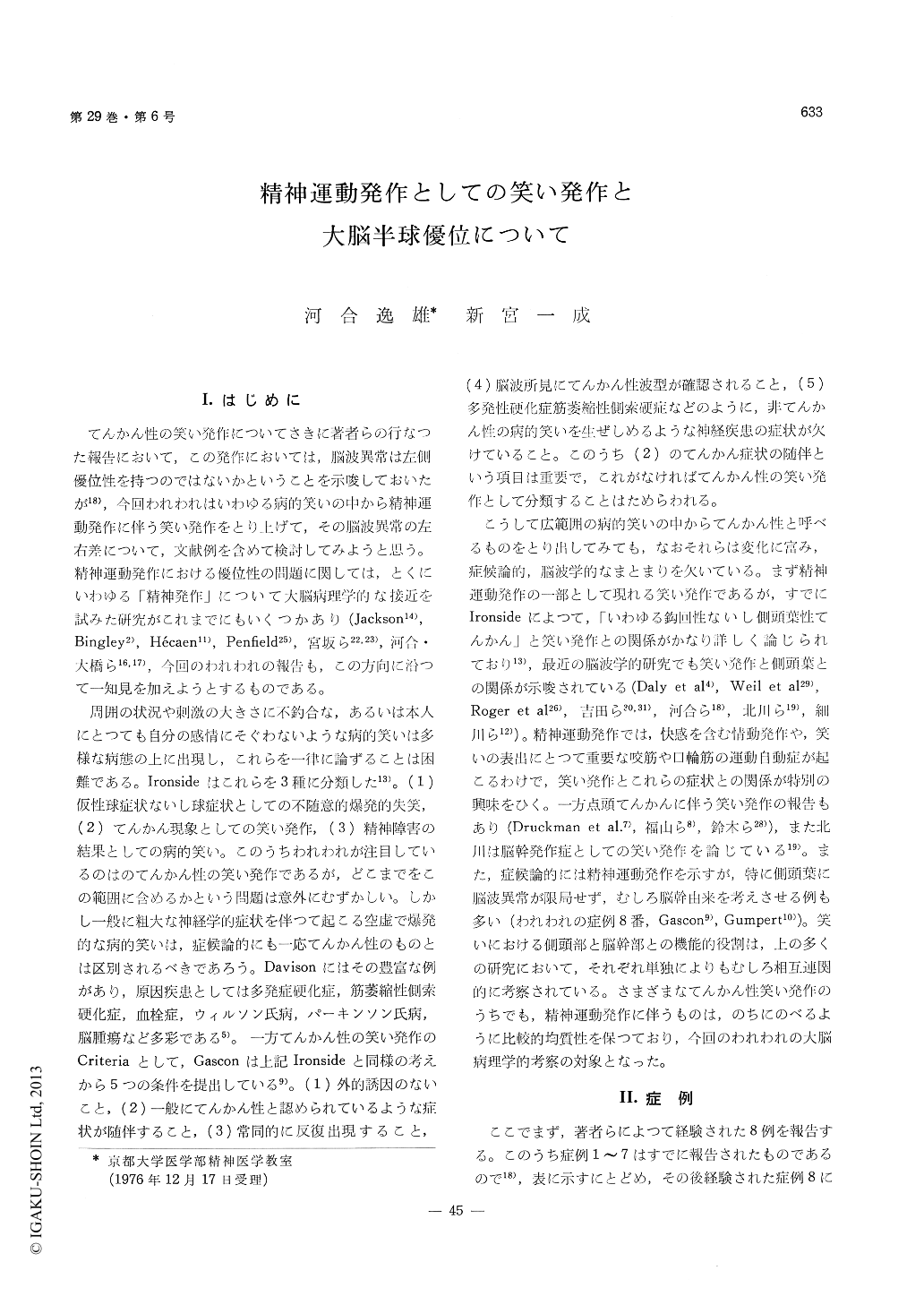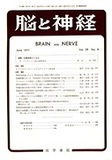Japanese
English
- 有料閲覧
- Abstract 文献概要
- 1ページ目 Look Inside
I.はじめに
てんかん性の笑い発作についてさきに著者らの行なつた報告において,この発作においては,脳波異常は左側優位性を持つのではないかということを示唆しておいたが18),今回われわれはいわゆる病的笑いの中から精神運動発作に伴う笑い発作をとり上げて,その脳波異常の左右差について,文献例を含めて検討してみようと思う。精神運動発作における優位性の問題に関しては,とくにいわゆる「精神発作」について大脳病理学的な接近を試みた研究がこれまでにもいくつかあり(Jackson14),Bingley2),Hécaen11),Penfield25),宮坂ら22,23),河合・大橋ら16,17),今回のわれわれの報告も,この方向に沿つて一知見を加えようとするものである。
周囲の状況や刺激の大きさに不釣合な,あるいは本人にとつても自分の感情にそぐわないような病的笑いは多様な病態の上に出現し,これらを一律に論ずることは困難である。Ironsideはこれらを3種に分類した13)。(1)仮性球症状ないし球症状としての不随意的爆発的失笑,(2)てんかん現象としての笑い発作,(3)精神障害の結果としての病的笑い。このうちわれわれが注目しているのはのてんかん性の笑い発作であるが,どこまでをこの範囲に含めるかという問題は意外にむずかしい。しかし一般に粗大な神経学的症状を伴つて起こる空虚で爆発的な病的笑いは,症候論的にも一応てんかん性のものとは区別されるべきであろう。Davisonにはその豊富な例があり,原因疾患としては多発症硬化症,筋萎縮性側索硬化症,血栓症,ウィルソン氏病,パーキンソン氏病,脳腫瘍など多彩である5)。一方てんかん性の笑い発作のCriteriaとして,Gasconは上記Ironsideと同様の考えから5つの条件を提出している9)。(1)外的誘因のないこと,(2)一般にてんかん性と認められているような症状が随伴すること,(3)常同的に反復出現すること,(4)脳波所見にてんかん性波型が確認されること,(5)多発性硬化症筋萎縮性側索硬症などのように,非てんかん性の病的笑いを生ぜしめるような神経疾患の症状が欠けていること。このうち(2)のてんかん症状の随伴という項目は重要で,これがなければてんかん性の笑い発作として分類することはためらわれる。
We selected 34 cases of psychomotor epilepsy withlaughing fits from our own studies and from theliterature, and then studied their EEG results inthe light of cerebral dominance. We excluded suchcases as showed laughing fits with appropriatepleasant feelings which could be interpreted as"emotional fits".
As a control group, we adopted cases from aprevious survey of psychomotor epilepsy. Thus, ofthe cases of psychomotor epilepsy with laughingfits, 26 showed EEG abnormalities on the left side,and 8 on the right. Of the cases of psychomotorepilepsy without laughing fits, 151 showed EEGabnormalities on the left side, and 131 on the right.It is unfortunate that handedness has not beennoted in most cases in the literature.
Results showed that the incidence of EEG abnor-malities on the left side in cases of psychomotorepilepsy with laughing fits was statistically higherthan in those cases without laughing fits. Mean-while, several authors have pointed out thatpsychical seizures (apart from aphasic fits) areusually found in cases with right-sided lesions.
We might presume that, as far as laughter isconcerned, the deep temporal structures which dis-pose of human emotional functions are workingmore actively in the left hemisphere, and are con-nected with the functions of thought and language.However, if we premise an antagonism betweenthe two cerebral hemispheres, we can conjecturethat disturbances in the left hemisphere liberatethe emotional functions situated in the right hemi-sphere, thus producing the symptom of ictal laugh-ter.

Copyright © 1977, Igaku-Shoin Ltd. All rights reserved.


